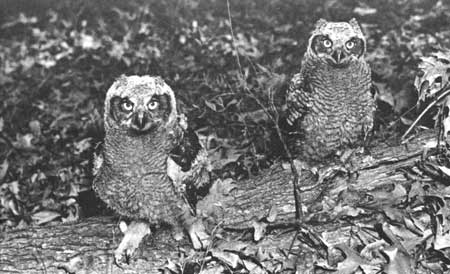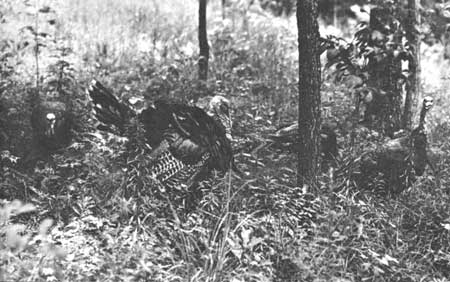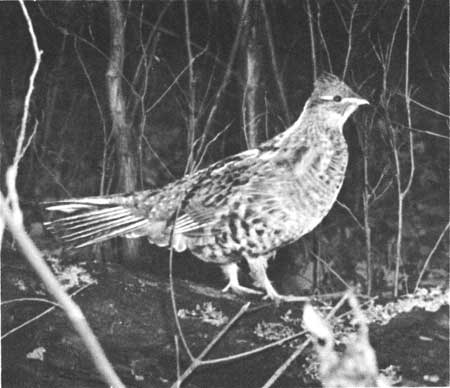|
GREAT SMOKY MOUNTAINS National Park |
 |
Birds
To many visitors a drive over the transmountain road, which bisects the park at right angles to the main ridge, serves as an excellent cross section to the birdlife of this area. Starting at Gatlinburg, Tenn., where the elevation is 1,300 feet above sea level, or at Cherokee, N.C., at 1,900 feet, we find such common permanent residents as cardinal, Carolina wren, song sparrow, tufted titmouse, eastern phoebe, Carolina chickadee, and various woodpeckers. During the breeding season, species which become just as prevalent include the red-eyed and the yellow-throated vireos, wood thrush, indigo bunting, Acadian flycatcher, brown thrasher, and such warblers as the yellow, prairie, black-and-white, hooded, Kentucky, worm-eating, yellow-throated, and golden-winged, the yellowthroat, American redstart, ovenbird, yellow-breasted chat, and Louisiana water thrush. By the time we reach an elevation of approximately 3,500 feet, such strikingly arrayed breeding birds as the scarlet tanager and rose-breasted grosbeak might be added to our list, and from there to the top of the Smokies the birdlife closely resembles that of northern New England.
Owing to more extensive logging operations in the years before this area became a National Park, the North Carolina side of the transmountain road has relatively little spruce and fir below Newfound Gap (elev., 5,040 ft.); on the Tennessee side, this Canadian-type forest extends upward from near 4,000 feet. There the wood thrush is replaced by the veery; the common crow, by the common raven; the Carolina chickadee, by the black-capped; the screech owl by the saw-whet. There the common warblers are the chestnut-sided (in the more open places), Canada and black-throated blue (in rhododendron thickets), and Blackburnian (in treetops). These high-altitude forests are the home of the olive-sided flycatcher, whose whistled question, "What peeves you?", can be heard for great distances.
 Young great horned owls. The eggs from which these birds emerged were laid in midwinter. No other birds begin their nesting activities so early in the year. Courtesy, Tennessee Conservation Department. |
Whether heard in Maine or in the Great Smokies, querulous nasal notes of the red-breasted nuthatch, the high-pitched lisping of the golden-crowned kinglet, the clear whistle of the solitary vireo, and the thrilling roundelay of the winter wren become associated with spruce and fir.
The crowlike bird that you may see in these higher altitudes is, in all probability, a raven; no bird symbolizes the untamed wilderness atmosphere of these mountains as does this black-feathered master of flight. If you hear its deep throaty notes there should be no question concerning its identity, but if the bird remains silent you might readily identify it by its soaring flight and wedge-shaped tail. Ravens occasionally utter clear liquid notes, resembling xylophone music. For many a bird watcher, the experience of being entertained by the side rolls, dips, and power dives of this magnificent bird against a background of unspoiled coniferous forests is more thrilling than the most elaborate man-staged exhibition. The latter is artificial, whereas the former is as real as the rain, the mountains, and the growing things. The raven is doing what its ancestors have done for many millions of years; but mankind, by encroaching ever more on the wilderness, has also come close to destroying the big ebony-colored bird, which is just as much a part of the picture as the unbroken ranks of spruce and fir. National Parks serve to preserve segments of the American wilderness so that future generations also can have the opportunity of experiencing some of the breathtaking sights which Audubon, Lewis and Clark, and Muir experienced.
Although red crossbills often appear in pine forests at the lower altitudes of the park, these eccentric and gregarious finches belong rightfully, in the Canadian zone. During some years these birds are quite plentiful, while at other times they may be rare or absent. In years gone by when cattle ranged on the high-mountain meadowlands, the herders knew this as the "salt bird." Crossbills are exceptionally fond of salt, and since they were very approachable while feeding on the salt which had been distributed for the benefit of the cattle, the name they were known by was entirely appropriate. Breeding takes place in the park, at least in some years, for there have been observations of the adults feeding young which must have left the nest but recently. Yet no nest has been discovered in the area. In this regard the red crossbill is like the saw-whet owl, a much rarer species which breeds in these mountains but whose nest or eggs have yet to be found here.
During some winters the pine siskin, another unpredictable finch, may be the most abundant species of bird in the park. Flocks consisting of several hundred birds may frequent Newfound Gap in late autumn or early winter, milling about in an exceptionally restless manner and, all the while, uttering a distinctive unmusical buzzing crescendo. There is some evidence that a few may nest in the park, but more information is needed.
Of all the Canadian-zone birds in the park, none is more plentiful or more likely to be encountered along the high-altitude trails than the Carolina junco. This is the approachable, dark-gray sparrow-size bird which you will find hopping about unconcernedly in the parking areas at Newfound Gap and Clingmans Dome. When it flits away to another feeding place, the white of the outer tail feathers shows conspicuously. It resembles the slate-colored junco of New England and Canada, but is larger, of a lighter and more uniform coloration, and has a darker bill. In winter, when both the northern and the resident subspecies are present in the park, they often occur in the same flock. The song—a cheery, bell-like, tinkling trill—is much more musical than that of the chipping sparrow or worm-eating warbler with which it may be compared. The deeply cupped nest is built usually on the ground below overhanging roots; observant hikers often find the attractive nest when the close-sitting bird is flushed from the trailside. The first eggs may be laid in late April, and it is not unusual for a late snow to cover the ground close to the incubating bird. A second set may be laid in July.
Early frost may be the signal which causes the Carolina juncos to leave the dark coniferous forests of the higher Appalachians and wing their way down to the foothills, usually in October. Approximately 6 months later this migration is reversed. Here, as elsewhere throughout the world where high mountains are features of the landscape, certain birds have a vertical migration pattern.
In addition to the Carolina junco, there are other southern Appalachian breeding birds (subspecies) which are closely related to, but not identical with, more northern forms. These include the solitary vireo, brown creeper, winter wren, and black-throated blue warbler. The red crossbills are in need of further study to determine whether a resident population exists. The two breeding chickadees represent distinct species (Carolina and black-capped).
 Wild turkeys range over much of the park, but they are most often observed in Cades Cove and vicinity. They find acorns in the oak forests, grasshoppers and other insects in the open fields, and a variety of wild fruits in season. Courtesy, Tennessee Conservation Department. |
Wild turkeys, largest birds in the area, appear to be holding their own. You must keep in mind that National Parks give sanctuary to these birds and to all native forms of life (except fish). The bobcats, foxes, and other predators are given the same protection as those species on which they prey. Research has shown that predation—the act of one animal preying upon another—has been very much overrated in its effects upon animal populations. The cutting of forests, the draining of swamps, the construction of endless miles of highways, and various other man-caused changes to the landscape have had infinitely more influence on the welfare of our wildlife than predation. Also, the wild turkey populations in the National Park are probably affected more by the climatic conditions which prevail during the early life of the chicks, by diseases, and by the occasional failure of the acorn crop than they are by the attacks of other animals.
Along with the croak of a raven, another sound symbolic of wildness is the drumming of a ruffed grouse. This muffled crescendo, resembling the noise of an engine in the far distance, is made by the beating wings of the male while he perches on a log in the forest. Most of the drumming is done in April and October. Is the male proclaiming to other male grouse the fact that it is here that he has staked out his territory? Or, as some observers believe, does the male drum in order to attract the female's attention? Ruffed grouse are fairly common in some parts of the park, and they may be encountered from the lowest to the highest altitudes. Other birds whose distribution in the park shows no regard for altitudes include the robin, chimney swift, hairy woodpecker, bobwhite, ruby-throated hummingbird, black-throated green warbler, catbird, and rufous-sided towhee.
 Ruffed grouse on a drumming log in the forest. The males, by an accelerated beating of the wings, create the unique crescendo that you may hear, particularly in April and again in October. Courtesy, Tennessee Conservation Department. |
There are water impoundments along the park's western and southwestern boundaries, but within the area there are no permanent lakes or ponds. Consequently water and shore birds ordinarily bypass these mountains in their migrations. There have been instances, however, when numbers of night-flying coots, ducks, and shore birds have been grounded while snowstorms of late October and early November swirled over the Smokies. Apparently mistaking the wet glistening road for a watercourse, some of the birds, in trying to alight, were injured or killed by the impact. The only record of a golden plover in the park came during the first snow storm of the season, in late October 1953.
All bird observers know that any region, if studied long enough, is bound to have its list of rare or unexpected species. The Great Smokies is no exception. According to park records, a listing of the 10 rarest birds would include white pelican, common egret, brant, snow goose, pigeon hawk, red phalarope, laughing gull, sooty tern, red-cockaded woodpecker, and white-winged crossbill. Both the golden and bald eagles are quite rare, especially the former. The practically uninterrupted forest growth is unsuited to the golden eagle, whereas the absence of large bodies of water accounts for the scarcity of the bald eagle. The large reservoirs just outside the park have not, as yet, affected the status of the bald eagle in this area. Peregrine falcons nested on a prominent ridge near Alum Cave Bluffs for many years, but since they deserted this site these splendid birds have been observed rather infrequently.
Approximately 200 kinds of birds have been observed within the borders of the park. If we were to add the birds which have been reported from a narrow marginal band of land and water (reservoirs) within a few miles of the park's boundary, the number would approach 240. Permanent residents, such as robin, cardinal, and song sparrow, total more than 60; those found here only during the breeding season, such as chimney swift, wood thrush, and red-eyed vireo, total approximately the same. At least 100 kinds of birds have been observed in the park and immediate vicinity during the winter. Of that number, 90 percent have been seen by organized groups engaged in taking the annual Christmas bird count (1935-57) sponsored by the National Audubon Society. As many as 64 species have been observed in one day in the winter. The spring migration, featured by a large variety of warblers, is usually at its peak during the last days of April. Autumn migration is often characterized by a heavy flight of Swainson's thrushes in late September and early October.

|

|
| NPS History | History & Culture | National Park Service | Contact |
|
Last Modified: Sat, Nov 4 2006 10:00:00 pm PST |


